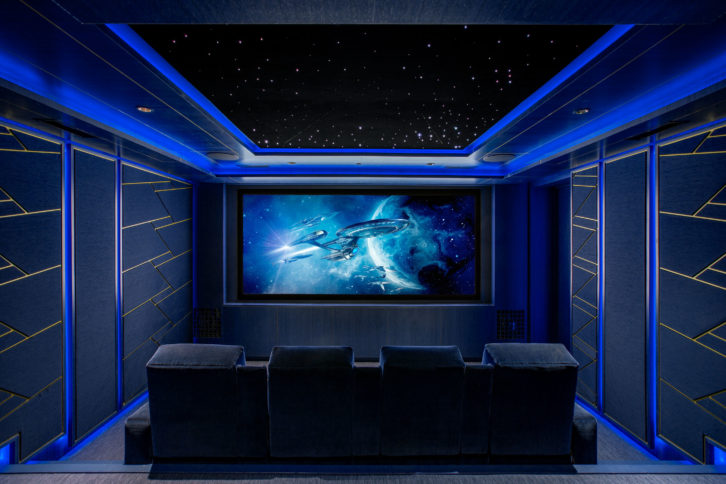Over the past several years we have seen dramatic changes and additions to the tangible elements available for screening and media rooms, but, before I delve into the design and technology, let’s discuss the sensory elements of the entertainment space experience.
Not wanting to get too esoteric, I want to explain that we are primarily dealing with three of the five fundamental senses — sight, touch, and hearing. They are the primary drivers of the home theater experience. The “exteroceptive” pathways included with these senses would be transduction, a form that is directly recognized by the brain. One of the other relevant secondary senses would be an “interoceptive” sense or the acknowledgment by the brain of spatial orientation. All of these become a reality of the total sensory experience and should be considerations for what technology and design functions are used to deliver a truly compelling experience.
As a designer of interiors used in entertainment spaces, my specific focus is on the following focused room design elements:
- Color palettes
- Fabrics, leathers, and materials
- Comfort
- Scalable elegance
- Lighting
Our collective and ongoing challenge is to incorporate all the preceding and make it work within the scope of each customer’s budget while providing a specifically curated experience for his/her personal space.

These design elements are constantly evolving and affected by new products and concepts that are driven by the genre, whether contemporary, thematic, traditional, or retro.
We won’t deep dive into the specifics of technology, but I do want to talk about the higher-level concepts that have evolved within the scope of each of the senses.
THE VISUAL EXPERIENCE — THE SENSE OF SIGHT
Arguably the visual experience is the primary element of the sensory experience. This encompasses what customers see when they walk into their spaces. With the lights on as they enter the space and become situated, they experience colors, the sense of size, and, through the amazing options available with current lighting design technology, the ability to change the visual experience within the design elements of the space.
Generally, this is a small percentage of what they will experience because once the show begins and the lights dim, the content’s visuals and sound take over!
Today’s current video technology is amazing. It is difficult to keep up with as there are so many options and performance parameters to consider. Driven by available content — including streaming, direct view from cable or satellite, Blu-ray or proprietary video servers, and DCP — the bar is being raised at an exceptionally rapid pace. At the same time, both two-piece projection and flat-panel technology is continuing to improve what feels like minute-by-minute.
How this is integrated into the design of the room is a crucial design element that we consider in providing an optimal result for the customer.
THE AUDIO EXPERIENCE – SENSE OF HEARING
From a standard 2-channel configuration to the highest level of immersive audio, the quality and performance of today’s audio products is nothing short of epic. Thanks to the movie and music industry, immersive audio content is becoming the standard. One can re-create sound that surpasses movie theaters and mimics the experience that content creators, directors, and producers work with when they are developing and fine-tuning their projects.
Scalability and performance are the variables to consider when designing your customers’ private entertainment spaces — whether it is a basic speaker configuration or a multichannel immersive experience with full frequency range capability. This is where you can venture into the senses beyond sight, touch, and hearing by controlling the total capability of what can be “felt” by the customers as they immerse themselves into the performance of their personal entertainment spaces.
Again, it is very important how these systems are integrated unobtrusively into the design of the space.
THE ELEMENT OF “TOUCH” — SENSE OF FEELING
This third sense is as important as the visual and audio experiences. What do your customers feel when they walk into their rooms, sit in their custom-designed seats, turn down the lights, and fire up the movie or other programs? Is the seating visually appealing and ergonomically comfortable with fabrics or leathers that are conducive to sitting for two to three hours (or more) of entertainment? Do the seats have the controllability to adjust for optimal viewing and comfort? Do they have the options to enjoy a beverage or snack, plug in devices, or integrate personal lighting into each seat?
These elements are all considerations and, more important, available with a quality seating product.
Beyond the product’s capabilities, are the sight lines appropriate for all seating locations to have a complete visual experience? There are numerous design elements to consider in providing a successful outcome that will make your customers consider your work as an essential part of their personal lifestyle.
IN CONCLUSION
We just touched the surface on the sensory considerations of entertainment space design. As a proprietary designer of these specialized entertainment spaces, I want to emphasize the importance of working with an experienced, professional interiors provider and a qualified acoustic consultant that can help you with your projects. Both design and room performance are critical components of the outcome of your efforts.
It takes a qualified team to deliver a product that is world class — every time. It should be our collective goal to always provide an experience that massively exceeds our clients’ expectations.
The article was originally written for https://www.residentialsystems.com/features/theater-design/sense-sational-theater-design